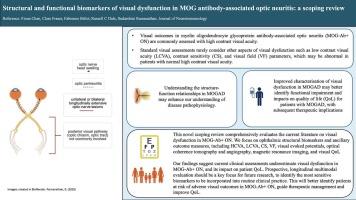Structural and functional biomarkers of visual dysfunction in MOG antibody-positive optic neuritis: a scoping review
IF 2.5
4区 医学
Q3 IMMUNOLOGY
引用次数: 0
Abstract
Introduction
Myelin-oligodendrocyte glycoprotein antibody-associated disease (MOGAD) commonly manifests as optic neuritis (ON) in association with serum MOG immunoglobulin G (MOG-IgG). This review will evaluate the literature on visual dysfunction in MOG-IgG ON, with a focus on ophthalmic structural biomarkers and ancillary outcome measures.
Methods
PubMed was systematically searched using the terms “optic neuritis”, “visual outcomes” and “myelin-oligodendrocyte glycoprotein” between 2007 to January 2025. High-contrast visual acuity (HCVA), low-contrast visual acuity (LCVA), contrast sensitivity, visual fields (VF), electrophysiology, optical coherence tomography (OCT)/angiography, magnetic resonance imaging (MRI) and quality of life (QoL) were evaluated.
Results
35 studies and 2335 patients were included. 89 % of studies reported HCVA. OCT and MRI were reported in 63 % and 43 % of studies, respectively. MOG-IgG ON had moderate-severe HCVA loss at nadir but good HCVA recovery. MRI features characteristic to MOG-IgG ON include longitudinally extensive lesions +/− perineural enhancement. OCT in acute MOG-IgG ON revealed moderate-severe peripapillary retinal nerve fibre layer (p-RNFL) swelling. However severe axonal loss was noted in chronic outcomes, despite preservation of HCVA, highlighting a recognised structure-function discordance. Only 31 % reported on VFs, 17 % on LCVA, and 14 % on VEPs, all of which demonstrated abnormalities even in patients with normal HCVA. Only one study reported on contrast sensitivity or QoL.
Conclusion
Current clinical assessments may underestimate visual dysfunction in MOG-IgG ON. Prospective, longitudinal multimodal evaluation should be a key focus for future research, to identify the most sensitive biomarkers to be incorporated into routine clinical practice. This will better identify patients at risk of adverse visual outcomes in MOG-IgG ON, guide clinical management and improve QoL.

MOG抗体阳性视神经炎中视觉功能障碍的结构和功能生物标志物:范围综述
髓鞘少突胶质细胞糖蛋白抗体相关疾病(MOGAD)通常表现为视神经炎(ON),与血清MOG免疫球蛋白G (MOG- igg)相关。本综述将对MOG-IgG on的视觉功能障碍的文献进行评估,重点关注眼科结构生物标志物和辅助结果测量。方法系统检索spubmed 2007年至2025年1月期间的“视神经炎”、“视觉结果”和“髓鞘-少突胶质细胞糖蛋白”。评估高对比视力(HCVA)、低对比视力(LCVA)、对比敏感度、视野(VF)、电生理、光学相干断层扫描(OCT)/血管造影、磁共振成像(MRI)和生活质量(QoL)。结果共纳入35项研究和2335例患者。89%的研究报告了HCVA。OCT和MRI分别占63%和43%的研究报告。MOG-IgG ON在最低点时HCVA损失中度至重度,但HCVA恢复良好。MOG-IgG ON的MRI特征包括纵向广泛病变+/−神经周围强化。急性MOG-IgG ON OCT显示中重度乳头周围视网膜神经纤维层(p-RNFL)肿胀。然而,尽管保留了HCVA,但在慢性结局中仍注意到严重的轴突损失,突出了公认的结构-功能不一致。只有31%报告了VFs, 17%报告了LCVA, 14%报告了vep,即使在HCVA正常的患者中也显示出异常。只有一项研究报告了对比敏感性或生活质量。结论目前的临床评估可能低估了MOG-IgG ON的视觉功能障碍。前瞻性、纵向的多模态评估应该是未来研究的重点,以确定最敏感的生物标志物,并将其纳入常规临床实践。这将更好地识别MOG-IgG ON中存在不良视力结局风险的患者,指导临床管理,提高生活质量。
本文章由计算机程序翻译,如有差异,请以英文原文为准。
求助全文
约1分钟内获得全文
求助全文
来源期刊

Journal of neuroimmunology
医学-免疫学
CiteScore
6.10
自引率
3.00%
发文量
154
审稿时长
37 days
期刊介绍:
The Journal of Neuroimmunology affords a forum for the publication of works applying immunologic methodology to the furtherance of the neurological sciences. Studies on all branches of the neurosciences, particularly fundamental and applied neurobiology, neurology, neuropathology, neurochemistry, neurovirology, neuroendocrinology, neuromuscular research, neuropharmacology and psychology, which involve either immunologic methodology (e.g. immunocytochemistry) or fundamental immunology (e.g. antibody and lymphocyte assays), are considered for publication.
 求助内容:
求助内容: 应助结果提醒方式:
应助结果提醒方式:


